

Navigating through a collection of items in your Webflow CMS can sometimes be a cumbersome experience for users. However, with the Previous Next Navigation for CMS technique, you can effortlessly create intuitive previous and next buttons for items in your Webflow CMS collection. This technique, showcased in a cloneable by Finsweet, allows users to seamlessly move between items, enhancing the overall user experience.
Why Use Previous Next Navigation?
- Improved Usability: Users can easily browse through your content without having to return to a main listing page.
- Enhanced Interactivity: Adding navigation buttons makes your site more engaging and interactive.
- Streamlined Experience: Simplifies the navigation process, making it more intuitive for users to find related content.
How It Works
The Previous Next Navigation for CMS technique leverages Webflow’s powerful CMS capabilities. By integrating this feature, you can dynamically generate navigation buttons that link to the previous and next items in your collection. This is particularly useful for blogs, portfolios, product listings, and any other content-heavy site.
Getting Started
- Clone the Project: Start by cloning the Finsweet project that demonstrates this technique.
- Customize: Tailor the navigation buttons to match your site’s design and branding.
- Implement: Integrate the cloned project into your Webflow site and connect it to your CMS collection.
Benefits
- User-Friendly: Makes it easier for visitors to explore your content.
- Time-Saving: Reduces the need for custom coding, allowing you to focus on content creation.
- Versatile: Can be used across various types of CMS collections.
Conclusion
By using the Previous Next Navigation for CMS technique, you can add an extra layer of interactivity and usability to your Webflow projects. This simple yet effective feature can significantly enhance the user experience, making your site more engaging and easier to navigate. Give it a try and see the difference it makes!

Navigating through a collection of items in your Webflow CMS can sometimes be a cumbersome experience for users. However, with the Previous Next Navigation for CMS technique, you can effortlessly create intuitive previous and next buttons for items in your Webflow CMS collection. This technique, showcased in a cloneable by Finsweet, allows users to seamlessly move between items, enhancing the overall user experience.
Why Use Previous Next Navigation?
- Improved Usability: Users can easily browse through your content without having to return to a main listing page.
- Enhanced Interactivity: Adding navigation buttons makes your site more engaging and interactive.
- Streamlined Experience: Simplifies the navigation process, making it more intuitive for users to find related content.
How It Works
The Previous Next Navigation for CMS technique leverages Webflow’s powerful CMS capabilities. By integrating this feature, you can dynamically generate navigation buttons that link to the previous and next items in your collection. This is particularly useful for blogs, portfolios, product listings, and any other content-heavy site.
Getting Started
- Clone the Project: Start by cloning the Finsweet project that demonstrates this technique.
- Customize: Tailor the navigation buttons to match your site’s design and branding.
- Implement: Integrate the cloned project into your Webflow site and connect it to your CMS collection.
Benefits
- User-Friendly: Makes it easier for visitors to explore your content.
- Time-Saving: Reduces the need for custom coding, allowing you to focus on content creation.
- Versatile: Can be used across various types of CMS collections.
Conclusion
By using the Previous Next Navigation for CMS technique, you can add an extra layer of interactivity and usability to your Webflow projects. This simple yet effective feature can significantly enhance the user experience, making your site more engaging and easier to navigate. Give it a try and see the difference it makes!





